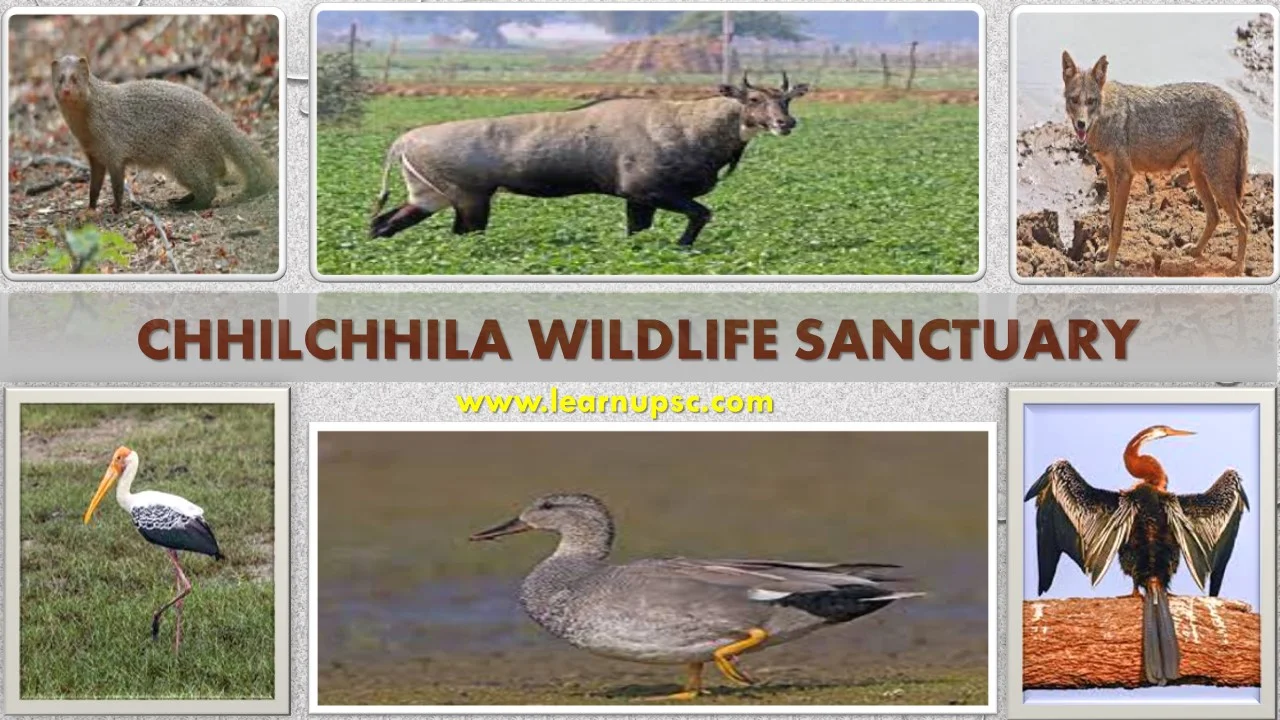Chhilchhila Wildlife Sanctuary UPSC
The Chhilchhila Wildlife Sanctuary is located in the state of Haryana, India. It is also known as Seonthi Reserve Forest. It is known for its significance in bird conservation and for providing a habitat for various plant and animal species.
Chhilchhila Wildlife Sanctuary is recognized as a bird sanctuary, indicating its importance as a habitat for a wide variety of bird species. It serves as a crucial stopover and wintering ground for both resident and migratory birds, making it a destination for birdwatchers and ornithologists.
|
Table of Contents
|
Chhilchhila Wildlife Sanctuary Location
The Chhilchhila Wildlife Sanctuary is located near Kurukshetra University in Kurukshetra district in the Indian state of Haryana. The Chhilchhila Sanctuary is located in a depression which has a small lake created by an embankment.
Baba Rodanath Dera temple is on the periphery of the Chhilchhila Sanctuary.
Nearest Airport:
Chandigarh International Airport is the nearest major airport to Chhilchhila Wildlife Sanctuary. It is located in Chandigarh, which is the capital city of the neighboring state of Punjab. The airport is approximately 100-110 kilometers away from the sanctuary, and it serves as a gateway for air travel to the region.
Nearest Railway Station:
Yamunanagar-Jagadhri Railway Station is the nearest railway station to Chhilchhila Wildlife Sanctuary. It is situated in the city of Yamunanagar, which is relatively close to the sanctuary. The railway station is approximately 20-30 kilometers away from the sanctuary.
Chhilchhila Wildlife Sanctuary History
1. Establishment: In a significant step towards conservation, Chhilchhila Lake was officially declared a Bird Sanctuary on November 28, 1986. This designation, made under the Wildlife (Protection) Act, 1972, showcases the area's vital role in safeguarding avian species and their habitats.
2. Eco-sensitive Zone: Recognizing the importance of maintaining the ecological balance, a protective buffer zone has been established around Chhilchhila Wildlife Sanctuary. The intention behind this measure is to mitigate human impact and ensure the continued flourishing of wildlife and ecosystems within and beyond the sanctuary's borders.
Chhilchhila Wildlife Sanctuary Area
Chhilchhila Wildlife Sanctuary encompasses an area of approximately 0.29 square kilometers, making it a compact yet valuable hub of biodiversity. Despite its limited size, the sanctuary supports a diverse range of flora and fauna, showcasing the resilience of nature. It serves as a haven for bird enthusiasts, offering a unique ecosystem that attracts various bird species.
Chhilchhila Wildlife Sanctuary Flora
The presence of various plant species highlights the rich biodiversity and ecological significance of the sanctuary. The dominance of dry deciduous vegetation suggests an ecosystem well-suited to the climate and conditions of the area.
Here's a breakdown of the dominant plant species and categories:
Tree Species:
- Acacia arabica
- Azadirachta indica (Neem)
- Prosopis cineraria (Khejri)
- Eucalyptus
- Ficus benghalensis (Banyan)
- Zizyphus jujuba (Ber)
- Prosopis juliflora
- Cassia tora
- Ficus religiosa (Peepal)
- Dalbergia sissoo (Sissoo)
Small and Medium-Sized Woody Plants:
- Capparis decidua (Karir)
- Calotropis procera (Aak)
- Adhatoda vasica (Vasaka)
- Alhagi maurorum
- Xanthium strumarium
Weeds:
- Achyranthes aspera
- Amaranthus spinosus
- Boerhavia diffusa
- Chenopodium ambrosioides
- Malvastrum
- Parthenium
Aquatic Plant Species:
- Azolla
- Cyperus
- Hydrilla
- Typha
The presence of these plant species reflects the adaptability of flora to the sanctuary's environment, contributing to the diverse habitats that support various wildlife species.
Chhilchhila Wildlife Sanctuary Fauna (Chhilchhila Wildlife Sanctuary Animals)
Mammals:
- Nilgai
- Indian Hare
- Wild Boar
- Porcupine
- Indian Fox
- Jackal
- Jungle Cat
- Small Indian Civet
Birds:
- Oriental Darter
- Painted Stork
Wintering Migrant Birds:
- Gadwall
- Northern Pintail
- Northern Shoveller
- Common Teal
- Common Pochard
- Common Coot
- Mallard
- Indian Spot-billed Duck
- Knob-billed Duck
- Lesser Whistling Duck
- Cotton Teal
Reptiles:
- Indian Rock Python
- Indian Cobra
- Common Monitor Lizard
Chhilchhila Wildlife Sanctuary UPSC Questions
Q. In which state Chilla Wildlife Sanctuary is located?/Chhilchhila Wildlife Sanctuary is located in which district?
A. Chhilchhila Wildlife Sanctuary is located in the state of Haryana, India. It is situated in the Kurukshetra district of Haryana.
Q. What is Chhilchhila Wildlife Sanctuary is famous for?
A. Chhilchhila Wildlife Sanctuary is primarily known for being a haven for bird species, both resident and migratory. The sanctuary's bird sanctuary status underscores its significance as a vital stopover and wintering ground for various bird species, especially during the colder months. It provides essential habitat, food, and shelter for a diverse range of avian visitors.
The sanctuary's diverse flora and fauna, along with its compact size, contribute to its uniqueness and ecological importance. It serves as a place of conservation for various plant and animal species, promoting biodiversity in the region.
Furthermore, the establishment of an Eco-sensitive Zone around the sanctuary reflects the commitment to preserving the ecological balance and environment of the area, emphasizing its role in supporting the overall well-being of both wildlife and the surrounding ecosystem.
Overall, Chhilchhila Wildlife Sanctuary is famous for its role in bird conservation, its ecological significance, and its contribution to the protection of local biodiversity.


No comments:
Post a Comment